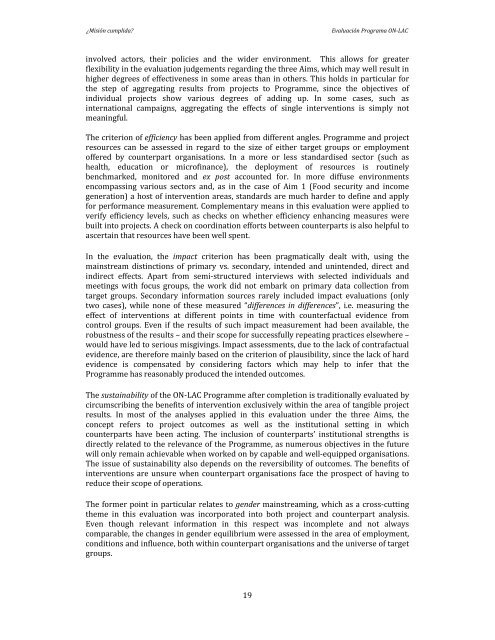¿MISION CUMPLIDA? EVALUACIÓN DEL PROGRAMA DE ... - Novib
¿MISION CUMPLIDA? EVALUACIÓN DEL PROGRAMA DE ... - Novib
¿MISION CUMPLIDA? EVALUACIÓN DEL PROGRAMA DE ... - Novib
You also want an ePaper? Increase the reach of your titles
YUMPU automatically turns print PDFs into web optimized ePapers that Google loves.
¿Misión cumplida? Evaluación Programa ON-LAC<br />
involved actors, their policies and the wider environment. This allows for greater<br />
flexibility in the evaluation judgements regarding the three Aims, which may well result in<br />
higher degrees of effectiveness in some areas than in others. This holds in particular for<br />
the step of aggregating results from projects to Programme, since the objectives of<br />
individual projects show various degrees of adding up. In some cases, such as<br />
international campaigns, aggregating the effects of single interventions is simply not<br />
meaningful.<br />
The criterion of efficiency has been applied from different angles. Programme and project<br />
resources can be assessed in regard to the size of either target groups or employment<br />
offered by counterpart organisations. In a more or less standardised sector (such as<br />
health, education or microfinance), the deployment of resources is routinely<br />
benchmarked, monitored and ex post accounted for. In more diffuse environments<br />
encompassing various sectors and, as in the case of Aim 1 (Food security and income<br />
generation) a host of intervention areas, standards are much harder to define and apply<br />
for performance measurement. Complementary means in this evaluation were applied to<br />
verify efficiency levels, such as checks on whether efficiency enhancing measures were<br />
built into projects. A check on coordination efforts between counterparts is also helpful to<br />
ascertain that resources have been well spent.<br />
In the evaluation, the impact criterion has been pragmatically dealt with, using the<br />
mainstream distinctions of primary vs. secondary, intended and unintended, direct and<br />
indirect effects. Apart from semi-structured interviews with selected individuals and<br />
meetings with focus groups, the work did not embark on primary data collection from<br />
target groups. Secondary information sources rarely included impact evaluations (only<br />
two cases), while none of these measured “differences in differences”, i.e. measuring the<br />
effect of interventions at different points in time with counterfactual evidence from<br />
control groups. Even if the results of such impact measurement had been available, the<br />
robustness of the results – and their scope for successfully repeating practices elsewhere –<br />
would have led to serious misgivings. Impact assessments, due to the lack of contrafactual<br />
evidence, are therefore mainly based on the criterion of plausibility, since the lack of hard<br />
evidence is compensated by considering factors which may help to infer that the<br />
Programme has reasonably produced the intended outcomes.<br />
The sustainability of the ON-LAC Programme after completion is traditionally evaluated by<br />
circumscribing the benefits of intervention exclusively within the area of tangible project<br />
results. In most of the analyses applied in this evaluation under the three Aims, the<br />
concept refers to project outcomes as well as the institutional setting in which<br />
counterparts have been acting. The inclusion of counterparts’ institutional strengths is<br />
directly related to the relevance of the Programme, as numerous objectives in the future<br />
will only remain achievable when worked on by capable and well-equipped organisations.<br />
The issue of sustainability also depends on the reversibility of outcomes. The benefits of<br />
interventions are unsure when counterpart organisations face the prospect of having to<br />
reduce their scope of operations.<br />
The former point in particular relates to gender mainstreaming, which as a cross-cutting<br />
theme in this evaluation was incorporated into both project and counterpart analysis.<br />
Even though relevant information in this respect was incomplete and not always<br />
comparable, the changes in gender equilibrium were assessed in the area of employment,<br />
conditions and influence, both within counterpart organisations and the universe of target<br />
groups.<br />
19



